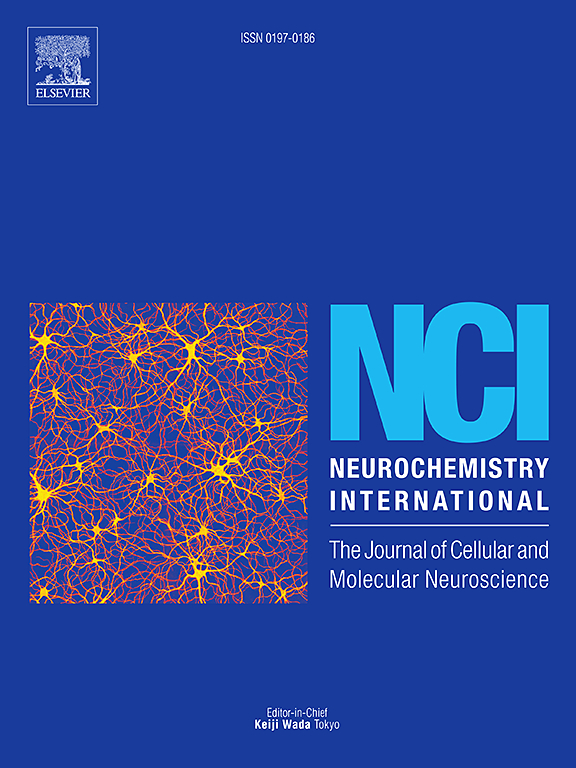Jun通过调控Timp1调节神经病理性疼痛过程中背根神经节神经元中与内质网应激相关的铁突变。
IF 4.4
3区 医学
Q2 BIOCHEMISTRY & MOLECULAR BIOLOGY
引用次数: 0
摘要
神经性疼痛(NP)是一种复杂的疾病,由影响躯体感觉神经系统的病变或疾病引起,严重影响患者的生活质量。最近的研究表明,铁变态反应可能参与了 NP 的诱导,但其确切机制仍不清楚。我们利用 GO 和 KEGG 通路富集分析对与铁突变相关的差异表达基因(FRDs)进行了功能注释。通过 STRING 和最大聚类中心性(MCC)算法,我们确定了五个中心 FRDs(Jun、Timp1、Egfr、Cdkn1a、Cdkn2a)。单细胞分析显示,Jun和Timp1在神经元中有显著表达。我们的研究证实了 NP 中铁质氧化与内质网应激(ERS)之间的关联,并验证了各种 NP 动物模型中枢 FRD 表达的变化。体外实验证明,Jun 特别是通过调节 Timp1 的表达来调控神经元的铁突变和 ERS。转录因子预测和 JASPAR 结合位点分析阐明了涉及 Jun 的调控网络。外部数据集的 ROC 曲线分析凸显了 NP 中枢 FRDs 和 ERS 相关差异表达基因(ERSRDs)的诊断潜力。通过比较毒物基因组学数据库(CTD),我们发现雌二醇(E2)是一种针对中枢FRD和ERSRD的潜在治疗药物。分子对接预测了其与 Jun 和 Timp1 的结合位点,体内实验证实 E2 可减轻 NP 并逆转 Jun 和 Timp1 的表达。这项研究强调了 Jun 和 Timp1 在铁突变和 ERS 之间相互作用中的关键作用,为治疗 NP 提供了新的见解和前景广阔的途径。本文章由计算机程序翻译,如有差异,请以英文原文为准。
Jun modulates endoplasmic reticulum stress-associated ferroptosis in dorsal root ganglia neurons during neuropathic pain by regulating Timp1
Neuropathic pain (NP) is a complex disorder caused by lesions or diseases affecting the somatosensory nervous system, severely impacting patients' quality of life. Recent studies suggest ferroptosis may be involved in NP induction, but its precise mechanisms remain unclear. We used GO and KEGG pathway enrichment analyses to functionally annotate ferroptosis-related differentially expressed genes (FRDs). Through STRING and the maximum cluster centrality (MCC) algorithm, we identified five hub FRDs (Jun, Timp1, Egfr, Cdkn1a, Cdkn2a). Single-cell analysis revealed significant expression of Jun and Timp1 in neurons. Our study confirmed the association between ferroptosis and endoplasmic reticulum stress (ERS) in NP and validated changes in hub FRD expression across various NP animal models. In vitro experiments demonstrated that Jun regulates neuronal ferroptosis and ERS, particularly by modulating Timp1 expression. Transcription factor prediction and JASPAR binding site analysis elucidated the regulatory network involving Jun. ROC curve analysis of external datasets highlighted the diagnostic potential of hub FRDs and ERS-related differentially expressed genes (ERSRDs) in NP. Using the Comparative Toxicogenomics Database (CTD), we identified estradiol (E2) as a potential therapeutic drug targeting hub FRDs and ERSRDs. Molecular docking predicted its binding sites with Jun and Timp1, and in vivo experiments confirmed that E2 alleviated NP and reversed the expression of Jun and Timp1. This study underscores the crucial role of Jun and Timp1 in the interplay between ferroptosis and ERS, offering new insights and promising avenues for NP treatment.
求助全文
通过发布文献求助,成功后即可免费获取论文全文。
去求助
来源期刊

Neurochemistry international
医学-神经科学
CiteScore
8.40
自引率
2.40%
发文量
128
审稿时长
37 days
期刊介绍:
Neurochemistry International is devoted to the rapid publication of outstanding original articles and timely reviews in neurochemistry. Manuscripts on a broad range of topics will be considered, including molecular and cellular neurochemistry, neuropharmacology and genetic aspects of CNS function, neuroimmunology, metabolism as well as the neurochemistry of neurological and psychiatric disorders of the CNS.
 求助内容:
求助内容: 应助结果提醒方式:
应助结果提醒方式:


